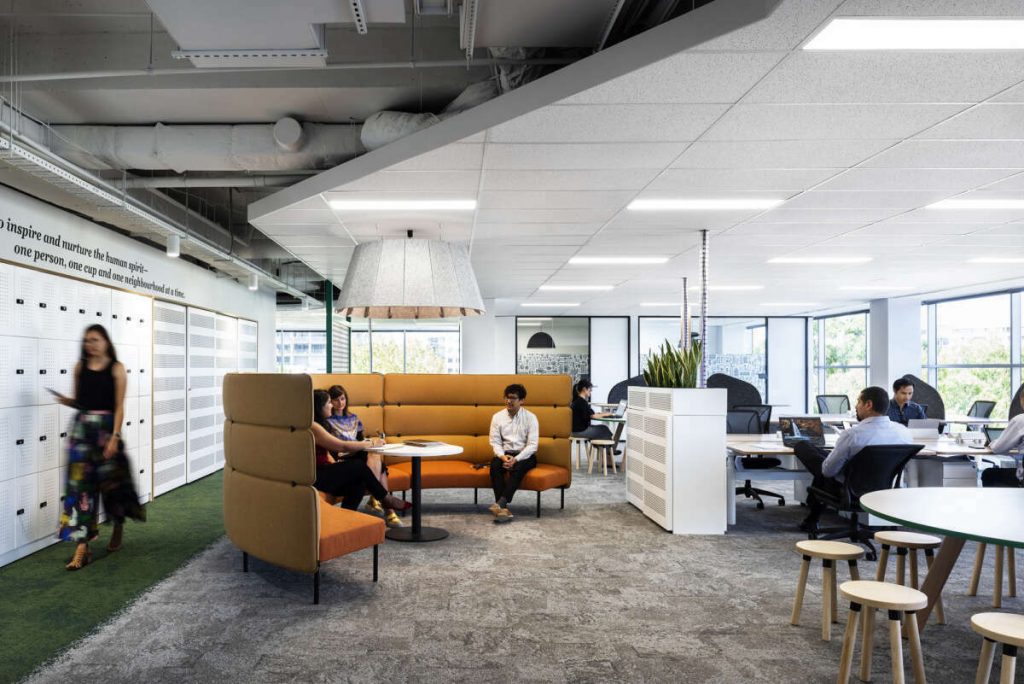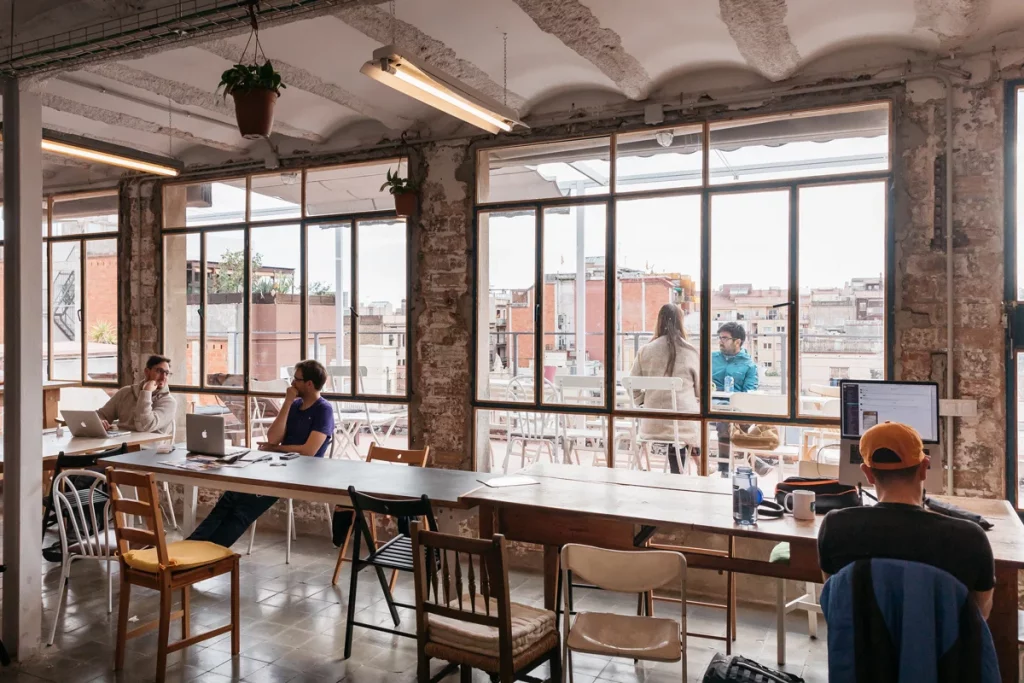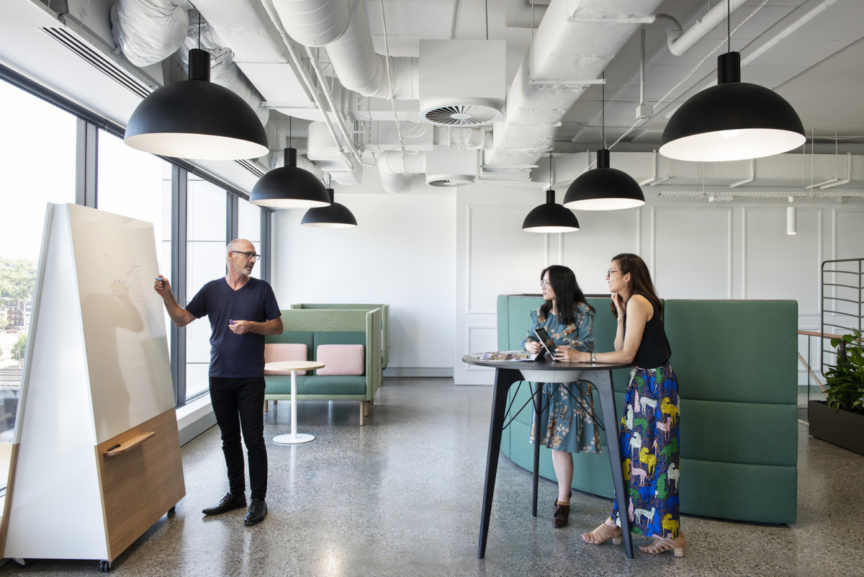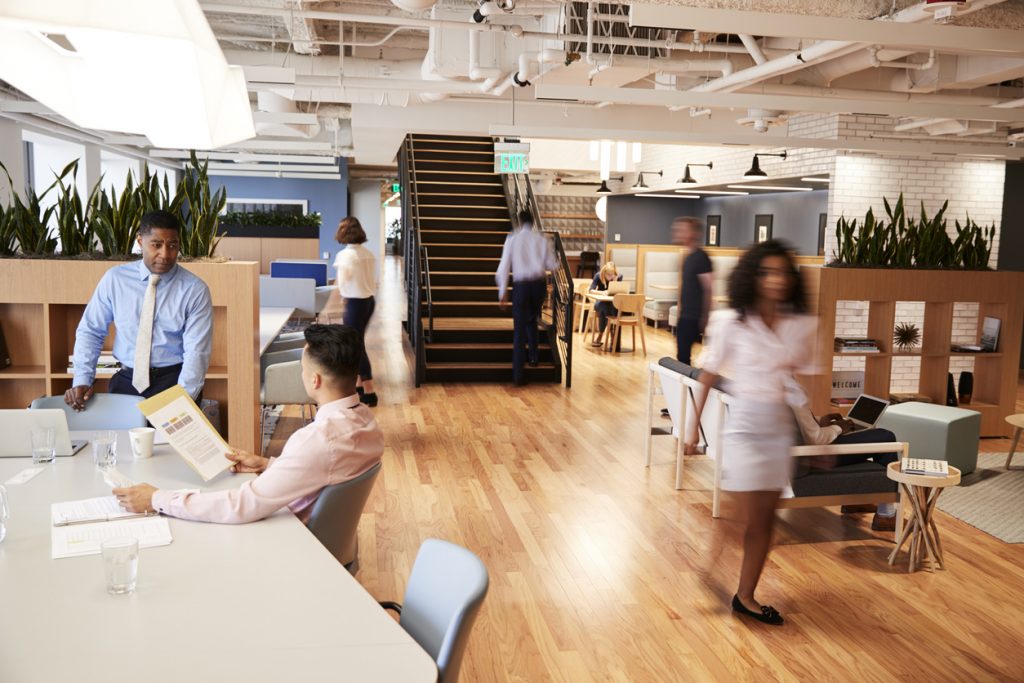Introduction
“Flex Office: Advantages and Disadvantages” is a pivotal topic in the discourse on modern workplace design. This model of flexible office arrangement caters to the dynamic needs of today’s businesses and their diverse workforces. By blending traditional office elements with the versatility of modern design, flex offices offer a unique solution that supports various working styles and operational scales.
Key Benefits Include:
- Adaptability: Spaces that evolve as business needs change, offering room for growth and downsizing without major disruptions.
- Cost Efficiency: Potential reduction in overhead costs by utilizing space as per actual needs, avoiding wastage.
- Enhanced Collaboration: Encourages a more interactive and cooperative work environment, fostering innovation.
However, adopting a flex office model comes with its set of challenges:
- Privacy and Noise: The open nature of many flex offices can lead to a lack of privacy and higher noise levels, which might disrupt concentration.
- Constant Change: Regular reconfigurations might hinder personalization of workspaces, affecting employee satisfaction.
The dual nature of “Flex Office: Advantages and Disadvantages” necessitates a balanced approach, ensuring businesses can leverage flexibility while addressing potential downsides. As noted by industry analysts like CBRE, the trajectory for flex office spaces is marked by significant growth, underscoring their increasing importance in the fabric of modern work environments (ConsultUS).
In the following sections, we will delve deeper into the advantages and disadvantages of flex offices, equipping you with the knowledge to decide if this is the right approach for your business operations.
What is a Flex Office?

A “Flex Office,” or flexible office, is a modern workplace solution that caters to the evolving needs of businesses and their employees. This concept revolves around creating a versatile environment where space and resources are utilized based on current demands, rather than maintaining a fixed setup. Here’s a closer look at the definition and basic concept, followed by a brief history of how this workspace model has evolved:
Definition and Basic Concept:
- Flexible Usage: Space in a flex office is not assigned permanently to individuals. Instead, desks and rooms are available on an as-needed basis, which can change daily or hourly.
- Scalable Design: The layout is adaptable, allowing organizations to scale their physical space up or down without the constraints of traditional fixed office setups.
- Tech-Enabled: Modern technologies facilitate hot-desking, room bookings, and other flexible work arrangements efficiently.
Brief History and Evolution:
- Origins: The concept of flexible workspaces began to gain traction in the late 1990s and early 2000s with the rise of internet technology, which allowed people to work remotely and still stay connected.
- Evolution: Over the years, the increasing demand for dynamic and cost-effective work solutions drove the proliferation of flex offices. Companies like WeWork capitalized on this trend by offering extensive flex office spaces, which not only catered to startups but also attracted large corporations.
- Current Trends: Today, flex offices are integral to strategies that support hybrid work models—blending remote work with office time to optimize productivity and employee satisfaction.
The growth and development of flex offices reflect a broader shift towards more agile and employee-centric workplace designs. As reported by CBRE, the flexibility offered by these spaces can lead to enhanced collaboration and efficiency, which are critical in today’s fast-paced business environment (ConsultUS).
Advantages of Flex Office

Flex offices are gaining popularity among modern businesses due to their multiple advantages, which range from financial savings to enhanced networking opportunities. Below, we explore three major benefits of adopting a flex office setup.
Cost Efficiency
Flex office environments significantly reduce overhead costs and the initial capital required to set up traditional office spaces. Here’s how they achieve cost efficiency:
- Lower Real Estate Costs: Companies are not bound to long-term leases. They can rent space according to current needs, which can fluctuate, leading to considerable savings.
- Reduced Utility Expenses: Sharing office space means shared utility costs. As not all employees are in the office simultaneously, this can lower electricity and heating bills.
- Minimal Setup and Maintenance: With shared resources and facilities, the need for individual investments in office equipment and furniture decreases.
This model not only slashes direct costs but also decreases the financial risk associated with traditional fixed office spaces.
Scalability
The ability to scale is crucial for growing businesses, and flex offices offer an optimal environment for this need:
- Adaptability to Business Growth: Companies can easily expand their office space as they grow or reduce it during downsizing, without the hassle of moving to a new location.
- Flexible Lease Terms: Unlike traditional leases, flex office spaces often come with short-term lease options. This flexibility allows businesses to adjust their space requirements without financial penalties.
Scalability ensures that businesses can remain agile, adapting quickly to market changes and internal company developments.
Enhanced Networking Opportunities
Flex offices are designed to foster a collaborative environment, which can lead to enhanced networking opportunities:
- Shared Common Areas: These spaces encourage interactions among different companies and professionals, which can lead to collaborations and partnerships.
- Community Events: Many flex office providers organize networking events, workshops, and seminars, which are perfect opportunities for businesses to connect and expand their networks.
- Diverse Professional Exposure: Being in a flex office exposes employees to varied industries and disciplines, which can broaden their knowledge and inspire innovative ideas.
The networking potential within flex offices is a substantial benefit, often leading to professional growth and business opportunities.
These benefits, as highlighted by sources like CBRE, demonstrate why more companies are moving towards flex office setups, appreciating their ability to enhance business operations and employee satisfaction (ConsultUS).
By integrating cost efficiency, scalability, and enhanced networking opportunities, flex offices present a compelling case for businesses looking to thrive in today’s dynamic economic landscape.
This overview of flex offices highlights their role in modern business practices, showcasing how they have become a cornerstone for companies aiming to innovate and adapt to the changing work landscape.
Disadvantages of Flex Office

While flex offices offer numerous benefits, they are not without their challenges. Below, we explore some of the key disadvantages that businesses might encounter in such setups, focusing on personal space, noise levels, and privacy concerns.
Lack of Personal Space
In flex office environments, the shared nature of the workspace can sometimes lead to issues related to personal space and storage:
- Limited Storage Options: Employees might find it challenging to store personal items securely, as most flex spaces do not provide permanent desks or storage.
- Shared Desks: Hot-desking, a common practice in flex offices, means no single workspace belongs to any one employee, which can make it hard to personalize or feel ownership over a workspace.
- Overcrowding: During peak hours, the space can become overcrowded, leading to a feeling of cramped conditions and limited personal space.
These issues can affect employee satisfaction and productivity, making it crucial for businesses to manage space allocation effectively.
H3: Noise and Distractions
The open design of many flex offices can significantly increase noise levels and lead to various distractions:
- Acoustic Challenges: Open spaces often lack soundproofing measures, which means sound travels easily, from phone calls to casual conversations.
- Frequent Movement: The flow of people moving in and out of the area, utilizing different facilities, can be distracting to those needing focus and quiet.
- Lack of Sound Privacy: Conversations, especially confidential ones, can be overheard, disrupting the work process and confidentiality.
Organizations may need to invest in noise management solutions like sound masking systems or provide access to quieter areas for concentrated work.
Privacy Concerns
Privacy is another significant issue in flex offices, especially concerning confidentiality and data security:
- Visual Privacy: The open layout often means that computer screens and documents are easily visible to passersby.
- Confidential Conversations: Without traditional private offices or soundproof meeting rooms, discussing sensitive information can be challenging.
- Data Security: The shared use of desks and storage areas can increase the risk of accidental data breaches.
Addressing these privacy concerns is essential, possibly through strategic office design and strict protocols regarding data handling and meetings.
The disadvantages outlined here highlight the need for careful consideration and planning when implementing a flex office model. Despite the challenges, many organizations find the advantages outweigh the drawbacks, especially when proactive measures are taken to mitigate these issues. As noted by sources like CBRE, understanding and addressing these concerns is key to leveraging the benefits of flex offices effectively (ConsultUS).
By acknowledging and planning for these disadvantages, businesses can better prepare for a successful transition to a flex office setup, ensuring that they maintain productivity and employee satisfaction.
Who Benefits Most from Flex Offices?

Flex offices are a versatile solution that can benefit a wide range of businesses and industries. However, certain types of companies might find these setups particularly advantageous due to their specific operational needs and workforce dynamics. Here’s an exploration of which sectors and business types stand to gain the most from adopting flex office setups.
Startups and Small Businesses
- Scalability: Startups and small businesses, which often experience fluctuating growth rates, benefit from the scalability of flex offices. These setups allow them to adjust their space requirements as their team sizes change without committing to long-term leases.
- Cost Efficiency: Minimizing overhead costs is crucial for smaller companies. Flex offices offer a cost-effective solution by reducing the need for large initial investments in office space and furniture.
Tech Companies
- Dynamic Project Needs: Tech companies, known for their project-based work and collaborative needs, find flex offices ideal for fostering innovation. Teams can easily regroup or expand their working areas as project requirements change.
- Attracting Talent: Offering a modern, flexible working environment can be a significant draw for talent, particularly in competitive fields like technology.
Creative Industries
- Collaboration: Agencies and firms in the creative sectors (like design, marketing, and media) thrive in environments that promote spontaneous collaboration and brainstorming, which flex offices facilitate.
- Space Utilization: These industries can also change the setup of their workspaces based on the type of creative work being done, from quiet zones for writers to open spaces for collaborative projects.
Consulting Firms
- Client-Focused Flexibility: Consulting firms often need spaces for meetings with clients that vary in frequency and size. Flex offices provide the ability to use conference rooms and private areas as needed without maintaining a large permanent office.
- Remote Flexibility: As consultants frequently travel, having an office that staff can come and go from as needed supports their mobile work style.
Large Corporates Looking for Innovation
- Hybrid Work Models: Larger companies looking to implement hybrid work models can use flex offices to reduce their core office space while still providing professional environments for employees when needed.
- Reduced Real Estate Footprint: This can significantly reduce the real estate footprint and associated costs, aligning with sustainability goals and financial efficiency.
Flex office setups represent a shift towards more dynamic, responsive business operations, allowing companies in these sectors to not only save on costs but also to enhance their operational agility. The growth in popularity of flex offices is a testament to their utility, reshaping how businesses think about workspace. According to a report by CBRE, the flex office market is expected to continue growing, underscoring its effectiveness in meeting modern workplace demands (ConsultUS).
By adopting flex offices, businesses in these sectors can leverage the benefits of a modern workspace that supports their growth, adaptability, and innovative processes.
Real-World Examples of Flex Office Implementation

Flex office strategies have been adopted by a variety of companies across different industries, showcasing their versatility and the broad range of benefits they can offer. Here are a few notable examples of businesses that have successfully implemented flex office environments, demonstrating the practical applications and effectiveness of this modern workspace concept.
WeWork – Pioneering Shared Workspace Models
- Background: WeWork is perhaps the most well-known provider of flexible workspaces, offering shared offices globally.
- Implementation: They specialize in providing aesthetically pleasing, amenity-rich office spaces that businesses can rent. Their model includes open spaces, private rooms, and shared desks.
- Outcome: This approach has not only attracted freelancers and startups but also large corporations looking to reduce their real estate costs and increase employee satisfaction.
Google – Adapting Office Spaces for Creativity and Flexibility
- Background: Google is renowned for its innovative approach to workplace design, emphasizing flexibility and employee well-being.
- Implementation: Google’s offices are designed to encourage collaboration and creativity, featuring open spaces that can be quickly reconfigured for different tasks and team sizes.
- Outcome: The flexibility in their office design allows employees to work in various settings that suit their needs, enhancing productivity and fostering a creative work culture.
Deloitte – Embracing the Hybrid Model
- Background: Deloitte has implemented a flex office approach within its broader hybrid work strategy.
- Implementation: They use a combination of assigned seating and hoteling, where employees can reserve workspaces when needed, allowing for a significant reduction in permanent office space.
- Outcome: This model supports a mobile workforce, accommodates client-facing roles with flexibility, and reduces overhead costs while maintaining operational effectiveness.
Zappos – Flexible Work Environments for Enhanced Collaboration
- Background: Zappos, an online retailer, integrates flexibility into its office layout to boost collaboration and employee satisfaction.
- Implementation: Their office design includes a variety of workspaces, such as quiet areas, collaboration zones, and leisure spaces.
- Outcome: This setup helps maintain high levels of team interaction and spontaneity, which are key to the company’s innovative and customer-focused culture.
These examples illustrate the effective use of flex office strategies to enhance organizational agility, employee satisfaction, and cost efficiency. Companies considering a move to flex office setups can draw valuable insights from these real-world applications. According to a study by CBRE, the successful implementation of flex offices often leads to improved business outcomes, including higher productivity and engagement among employees (ConsultUS).
By examining these case studies, businesses can better understand how to tailor flex office solutions to their specific needs, ensuring they harness the full potential of this modern workplace evolution.
Conclusion
As we have explored throughout this article, the concept of flex offices encompasses both significant advantages and notable challenges. These dynamic workspaces offer scalable, cost-effective solutions that can foster enhanced collaboration and networking opportunities, making them particularly attractive to startups, tech companies, and creative industries, among others.
Key Takeaways “Flex Office: Advantages and Disadvantages “:
- Versatility: Flex offices are highly adaptable, making them suitable for a variety of business models and fluctuating workforce sizes.
- Economic Efficiency: They can significantly reduce overhead costs associated with traditional office spaces.
- Collaboration and Innovation: By providing various interactive environments, flex offices can enhance productivity and spur innovation.
- Challenges: It is crucial for businesses to consider potential downsides such as lack of personal space, noise, and privacy issues, and address these in their planning and design.
Real-world examples from companies like WeWork, Google, Deloitte, and Zappos demonstrate the practical benefits and operational implementations of flex office strategies. These cases highlight how flex offices can be tailored to meet the specific needs of different organizations, ultimately contributing to their success and growth.
As the workplace continues to evolve, flex offices represent a compelling option for businesses looking to adapt to modern work demands. For companies contemplating a transition to more flexible workspace solutions, the insights shared here—backed by industry studies such as those from CBRE—provide a valuable framework for understanding how to best leverage these environments to achieve their strategic goals (ConsultUS).
In conclusion, whether flex offices are suitable for your business depends on your specific operational needs and cultural dynamics. By carefully weighing the advantages and addressing the challenges, companies can effectively integrate flex office setups into their long-term business strategies, ensuring they remain competitive and responsive in a rapidly changing work landscape. Ready to transform your workspace? Visit SpotBooker to find your ideal flex office solution today.






